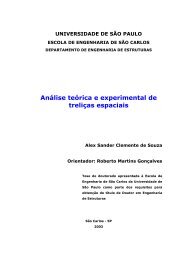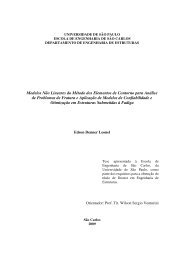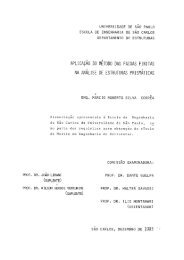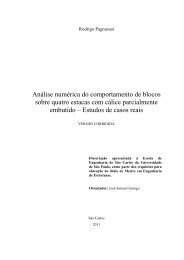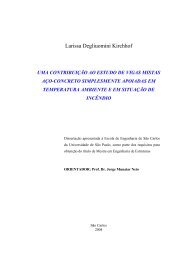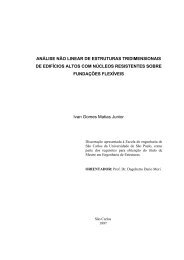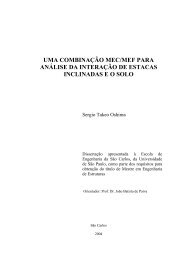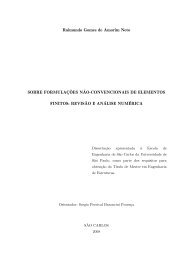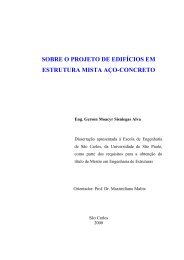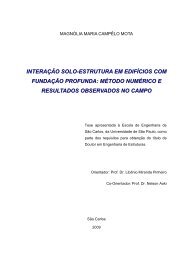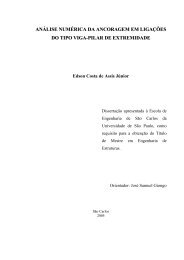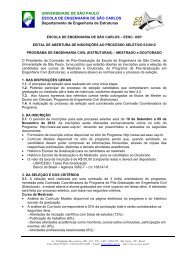análise de pavimentos de edifícios de concreto armado com a ...
análise de pavimentos de edifícios de concreto armado com a ...
análise de pavimentos de edifícios de concreto armado com a ...
You also want an ePaper? Increase the reach of your titles
YUMPU automatically turns print PDFs into web optimized ePapers that Google loves.
O elemento possui um campo <strong>de</strong> <strong>de</strong>slocamentos w(x) cúbico no seu<br />
domínio:<br />
2 3<br />
wx ( ) = a + a x+ a x + a x<br />
(A.2.1)<br />
1 2 3<br />
4<br />
113<br />
Deste modo, po<strong>de</strong>m ser <strong>de</strong>terminadas as rotações ( θ y ) em função da<br />
coor<strong>de</strong>nada x :<br />
θ y ( x)<br />
dw( x)<br />
2<br />
= = a2 + 2a3x+ 3 a4x (A.2.2)<br />
dx<br />
As rotações em torno do eixo x ( θ x ) , possuem campo linear no<br />
domínio do elemento, obviamente in<strong>de</strong>pen<strong>de</strong>nte dos <strong>de</strong>slocamentos<br />
verticais:<br />
( )<br />
θ x x = a + a x<br />
on<strong>de</strong>: ai - constantes.<br />
5 6 (A.2.3)<br />
Matricialmente, po<strong>de</strong>m-se escrever os campos <strong>de</strong> <strong>de</strong>slocamentos:<br />
⎧a<br />
⎫<br />
⎪<br />
a<br />
⎪<br />
⎪ ⎪<br />
⎧⎪<br />
wx ( ) ⎫⎪<br />
⎪a<br />
⎪<br />
wx ( )<br />
⎨ ⎬ = [ x x x x]<br />
⎨ ⎬ →<br />
θ ( x)<br />
a<br />
⎩⎪ x ⎭⎪<br />
⎪ ⎪ θx(<br />
x)<br />
⎪a<br />
⎪<br />
⎪ ⎪<br />
⎩⎪<br />
a ⎭⎪<br />
⎧<br />
1<br />
2<br />
⎪ ⎫<br />
2 3<br />
3 ⎪<br />
1 1<br />
⎨ ⎬ =<br />
4 ⎩⎪ ⎭⎪<br />
5<br />
6<br />
[ X]{} a<br />
(A.2.4)<br />
Os <strong>de</strong>slocamentos nodais po<strong>de</strong>m ser escritos em função das<br />
constantes e dos campos <strong>de</strong> <strong>de</strong>slocamentos impostos, <strong>com</strong>o segue:<br />
⎧ () 1<br />
w ⎫ ⎡1<br />
0 0 0 0 0 ⎤⎧a1<br />
⎫<br />
⎪ () 1 ⎪ ⎢<br />
⎥<br />
θ<br />
⎪<br />
y<br />
a<br />
⎪<br />
⎪ ⎪ ⎢<br />
0 1 0 0 0 0<br />
⎥⎪<br />
2 ⎪<br />
⎪ ( 2)<br />
2 3<br />
w ⎪<br />
⎪ ⎪ ⎢1<br />
Le Le Le<br />
0 0 ⎥⎪a3<br />
⎪<br />
⎨ ( 2)<br />
⎬ = ⎢<br />
2 ⎥⎨<br />
⎬ → {} u = [ A]{} a (A.2.5)<br />
⎪<br />
θ y ⎪ ⎢0<br />
1 2Le 3Le 0 0 ⎥⎪<br />
a4<br />
⎪<br />
⎪ () 1<br />
θ<br />
⎪ ⎢0<br />
0 0 0 1 0 ⎥⎪a<br />
⎪<br />
x<br />
5<br />
⎪ ⎪ ⎢<br />
⎥⎪<br />
⎪<br />
( 2)<br />
θ 0 0 0 0 1 L a<br />
x<br />
e 6<br />
⎩⎪<br />
⎭⎪<br />
⎣⎢<br />
⎦⎥<br />
⎩⎪<br />
⎭⎪<br />
−1<br />
Da expressão (A.2.5) conclui-se que { a} = [ A] {} u , que levada à<br />
expressão (A.2.4), permite reescrevê-la <strong>com</strong>o:



